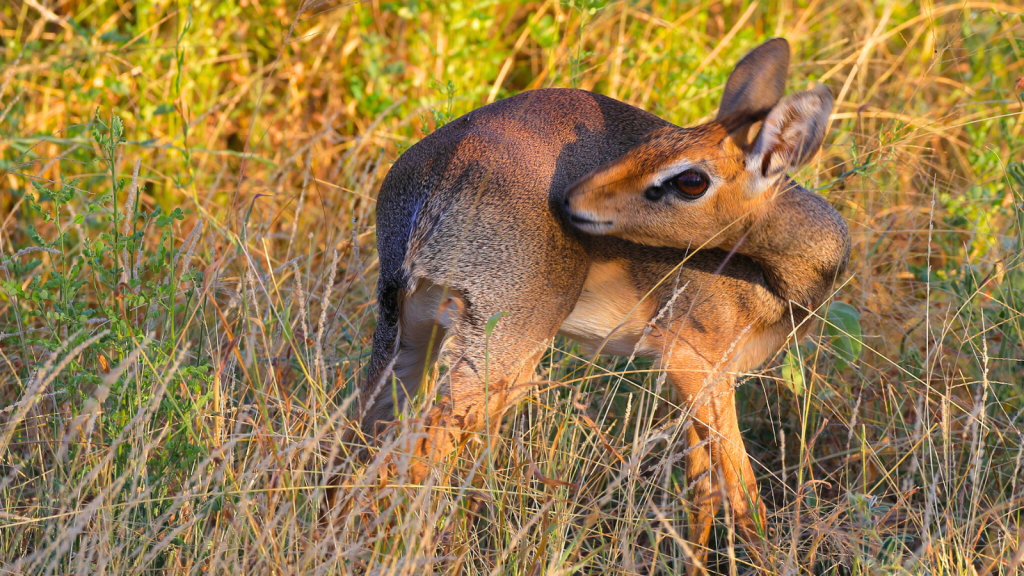The dik-dik is a tiny antelope that’s sure to make you smile. These pint-sized creatures are found in the bushlands of eastern and southern Africa, where they dart about on spindly legs and peer at the world through enormous, liquid eyes. Despite their diminutive size, dik-diks are full of surprises and quirks that make them truly special. From their unusual name to their clever survival tactics, these miniature marvels have plenty of fascinating traits to discover. Read on to learn some delightful details about these charming little antelopes.
They’re Named After a Sound They Make

When startled, dik-diks make a whistling call that sounds like “dik-dik.” This alarm call warns others of danger and gives the species its memorable name. The sound carries well through the bushes, helping these tiny antelopes stay safe from predators. Interestingly, both males and females make this distinctive call, which can be heard up to 50 meters away.
Dik-Diks Are Smaller Than Some Dogs

These petite antelopes stand only about 30-40 cm tall at the shoulder. That’s roughly the same size as a Jack Russell terrier! Their small size helps them hide from predators and move quickly through dense brush. Adult dik-diks typically weigh between 3-6 kg, making them one of the smallest antelopes in the world.
They Have Built-In Air Conditioning

Dik-diks have long, tubular noses that can be flared to help cool their blood. This clever adaptation helps them survive in hot, arid environments. By pumping blood through their large nose, they can lower their body temperature without losing precious water. This nasal cooling system is so effective that dik-diks rarely need to drink water, getting most of their moisture from the plants they eat.
Dik-Diks Are Loyal Partners

These antelopes typically mate for life. Pairs will defend their territory together and rarely stray far from each other. If one partner dies, the surviving dik-dik will often wait several months before seeking a new mate. This strong bond helps them raise their young more effectively, with both parents contributing to childcare.
They Have a Secret Weapon

Male dik-diks have tiny, sharp horns hidden in tufts of hair on their heads. These horns are used for territorial disputes with other males. The hair helps camouflage the horns, giving them an element of surprise in confrontations. Female dik-diks, on the other hand, don’t have horns at all, relying instead on their speed and agility for protection.
Dik-Diks Are Master Escape Artists

When threatened, these antelopes can run in a zig-zag pattern at speeds up to 42 km/h. They can also leap 1.5 meters high, helping them evade predators. Their agility and speed make up for their small size when it comes to survival. Dik-diks also have a unique crouching run that keeps them hidden in tall grass, making them even harder to catch.
They’re Constantly Grooming

Dik-diks have a preorbital gland near their eye that produces a dark, sticky substance. They use twigs and branches to spread this substance on their fur, marking their territory. This grooming behaviour helps them communicate with other dik-diks. The scent from these glands is so strong that humans can often smell it, describing it as musky or sweaty.
Dik-Diks Are Picky Eaters

These antelopes are browsers, meaning they eat leaves, buds, and fruits rather than grass. They’re selective feeders, choosing the most nutritious parts of plants. Their small size allows them to survive on less food than larger antelopes. Dik-diks have a special adaptation in their digestive system that allows them to extract maximum nutrition from their plant-based diet.
They Have Enormous Eyes

Dik-diks have disproportionately large eyes for their body size. These big eyes give them excellent vision, helping them spot predators in their bushy habitat. Their large eyes also make them appear incredibly cute to humans! In addition to great eyesight, dik-diks have large, mobile ears that can rotate independently, helping them detect danger from all directions.
Dik-Diks Are Early Risers

These antelopes are most active at dawn and dusk, a behaviour known as crepuscular. They use these cooler hours to feed and socialise, avoiding the intense heat of the African midday sun. This smart adaptation helps them conserve energy and stay safe. During the hottest parts of the day, dik-diks often rest in the shade, their brown-grey coats blending perfectly with the surrounding vegetation.
Becky is a fervent wildlife enthusiast and pet care expert with a diploma in canine nutrition. Her love for animals stretches beyond the domestic, embracing the wild tapestry of global fauna. With over a decade of experience in animal welfare, Becky lends her expertise to OutlandishOwl through insightful articles, captivating wildlife information, and invaluable guidance on pet nutrition. Her work embodies a deep commitment to understanding the intricate lives of animals and a passion for educating others on sustaining natural habitats. Becky's hands-on conservation efforts and her knack for translating complex dietary science into practical pet feeding tips make her an indispensable voice for creatures great and small.




